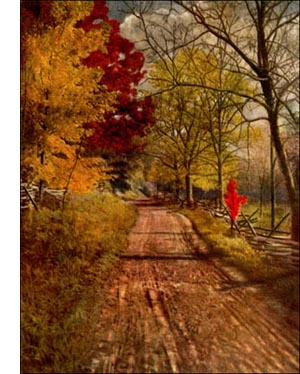Bald Cypress Tree
 Bald Cypress (Taxodium distichum, Rich.)-A tall pyramidal tree, 75 to 150 feet high, with pendulous branches, becoming broad and round headed when old. Trunk lobed above, strongly buttressed and usually hollow at the base. Roots long, horizontal, with vertical anchor roots. Bark pale reddish grey, scaly, divided by shallow fissures. Wood soft, light, brown, easily worked, durable. Buds minute, globular, scaly, silvery. Leaves deciduous with the branchlets linear, Z to 4 inch long, 2-ranked, spreading or scale-like, closely appressed. Flowers: monoecious, small; staminate in loose, drooping panicles, 4 to 6 inches long; pistillate globose, scaly, scattered near ends of twigs. Fruit annual, globular, woody cones, in pairs or solitary, 1 inch in diameter; seeds winged, 2 under each scale. Preferred habitat, swamps of coast or river bottoms. Distribution, Delaware to Florida; west into Texas; north along Mississippi to Missouri, Indiana and Illinois. Uses: Lumber for buildings, doors, shingles, cooperage, fencing and railroad ties. Planted as an ornamental tree in Northern States and in Europe.
Bald Cypress (Taxodium distichum, Rich.)-A tall pyramidal tree, 75 to 150 feet high, with pendulous branches, becoming broad and round headed when old. Trunk lobed above, strongly buttressed and usually hollow at the base. Roots long, horizontal, with vertical anchor roots. Bark pale reddish grey, scaly, divided by shallow fissures. Wood soft, light, brown, easily worked, durable. Buds minute, globular, scaly, silvery. Leaves deciduous with the branchlets linear, Z to 4 inch long, 2-ranked, spreading or scale-like, closely appressed. Flowers: monoecious, small; staminate in loose, drooping panicles, 4 to 6 inches long; pistillate globose, scaly, scattered near ends of twigs. Fruit annual, globular, woody cones, in pairs or solitary, 1 inch in diameter; seeds winged, 2 under each scale. Preferred habitat, swamps of coast or river bottoms. Distribution, Delaware to Florida; west into Texas; north along Mississippi to Missouri, Indiana and Illinois. Uses: Lumber for buildings, doors, shingles, cooperage, fencing and railroad ties. Planted as an ornamental tree in Northern States and in Europe.Familiar to the traveller through our Eastern and Southern seaboard regions are the cypress swamps, dismal, but picturesque withal, and exhibiting characteristics that set this tree quite apart from others. A conifer is ordinarily an evergreen tree. This one establishes its family claims by the brave array of button-like cones it ripens every autumn. But it is deciduous, shedding not only its yew-like leaves, but, surprisingly, most of the little twigs also that bear the leaves. So the winter finds the trees bare and dead looking, the tall, corrugated trunks of old ones often supporting heads as broad as the height, and hopelessly unsymmetrical. In the soft muck of deep swamps the trees spread out abruptly at the base into flying buttresses, each becoming hollow in course of time, as the base of the trunk is long before. Out on all sides stretch long, thick roots whose branches go down and anchor the tree, while the main ones seem designed to balance it on its uncertain foundation. The "knees" that rise up at intervals from the main roots and are distinguished from stumps by their smooth, conical shapes, are still a physiological puzzle. Many people believe that they gather air for the submerged root system. Others declare that they strengthen it. The cypresses keep their secrets from the prying investigator, and the solemn cormorants that build in the treetops will never tell.
I shall not forget an excursion on foot into one of the large bald cypress swamps of southern Florida in May. The dangerous part of the jaunt was the passage forced through a jungle of young pines, palmettoes and scrubby live oaks interlaced with wiry vines and creepers. Here rattlesnakes hide, and show fight when disturbed. Emerging at length into comparatively open timber, we stood surrounded by young cypresses with pale grey trunks, smooth, slender, and flaring widely at the bases. Among the trunks were stumps, and also knees, the latter smooth, as if the fibres went up one side and on down the other. Overhead was a feathery canopy of pale sage-green leaves. On rugged old trunks air plants found ample roothold. Orchids of sorts I had admired afar off in florists' windows held out great cataracts of bloom which were ours for the plucking. Vivid amaryllis flowers were similarly growing out of the trunks of these trees, with delicate ferns to keep them company. Under foot, the dry, sandy soil bore a crop of unfamiliar flowers. The rainy season which opens in May inundates this land for fully half of the year.
The wood of bald cypress is very important in the lumber trade, being soft, handsome, easily worked and durable in water and in the soil. Buckets and bowls are made by hollowing out knees of suitable sizes.
Lover though it be of Southern swamps, yet there is no handsomer spire of living green in any Northern upland park than this same bald cypress. In its early years the tree is perfectly symmetrical, trim and beautiful in the feathery lightness of its leafy spray. The roots keep out of sight and there is no hint of the outlandish hollow buttresses and bare knees that characterise the tree at home. Among strangers, the bald cypress puts on its best manners; there is no more conventional and fastidious tree in the park. The tree is cultivated also in a number of varieties, some dwarfs, some weeping forms, others of stricter spire forms that lend themselves to formal effects in gardens. The heads of cypress trees grow broad in moist soil, and assume narrower form in soil with scant moisture supply.